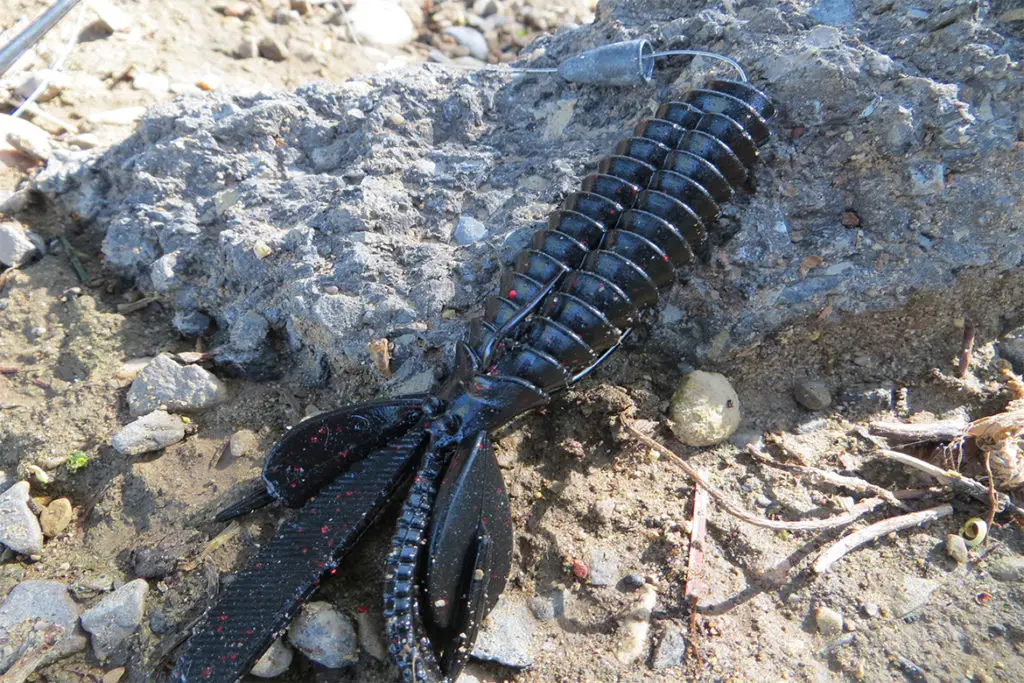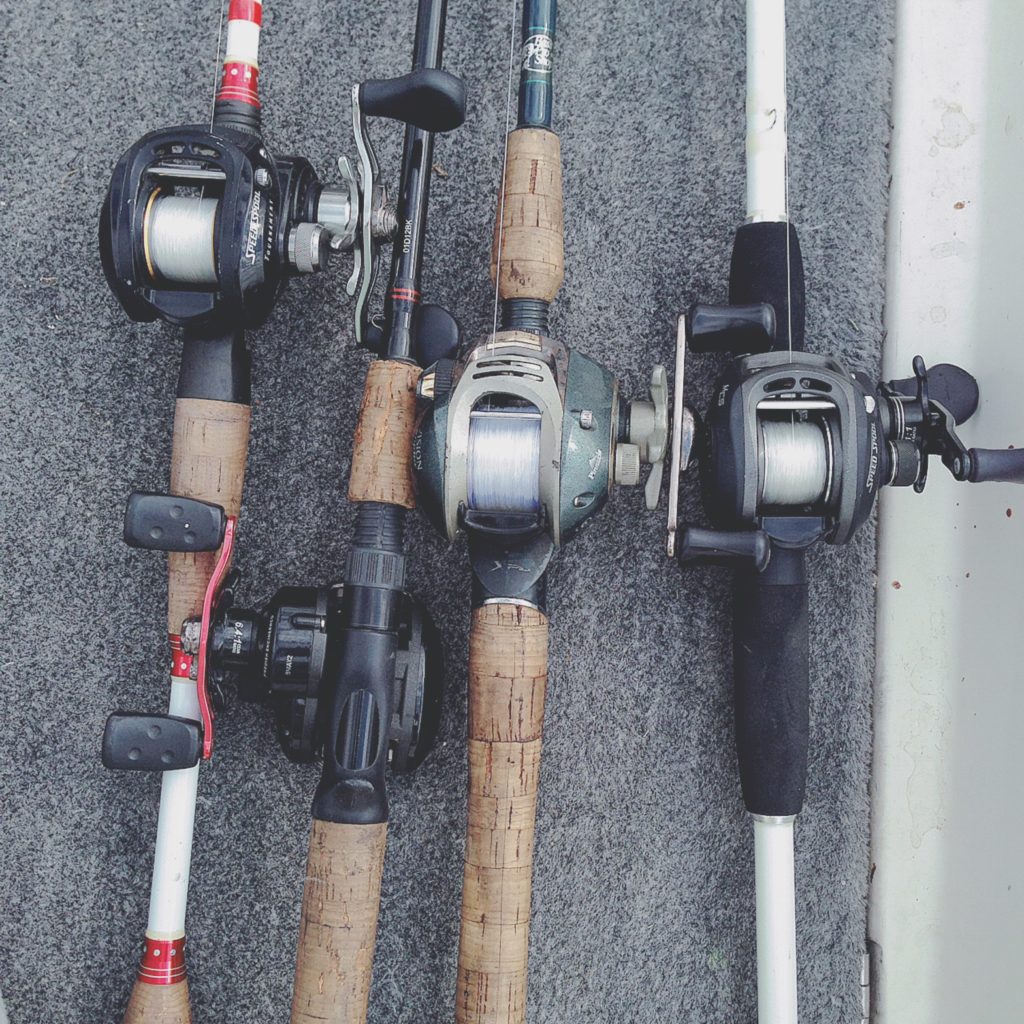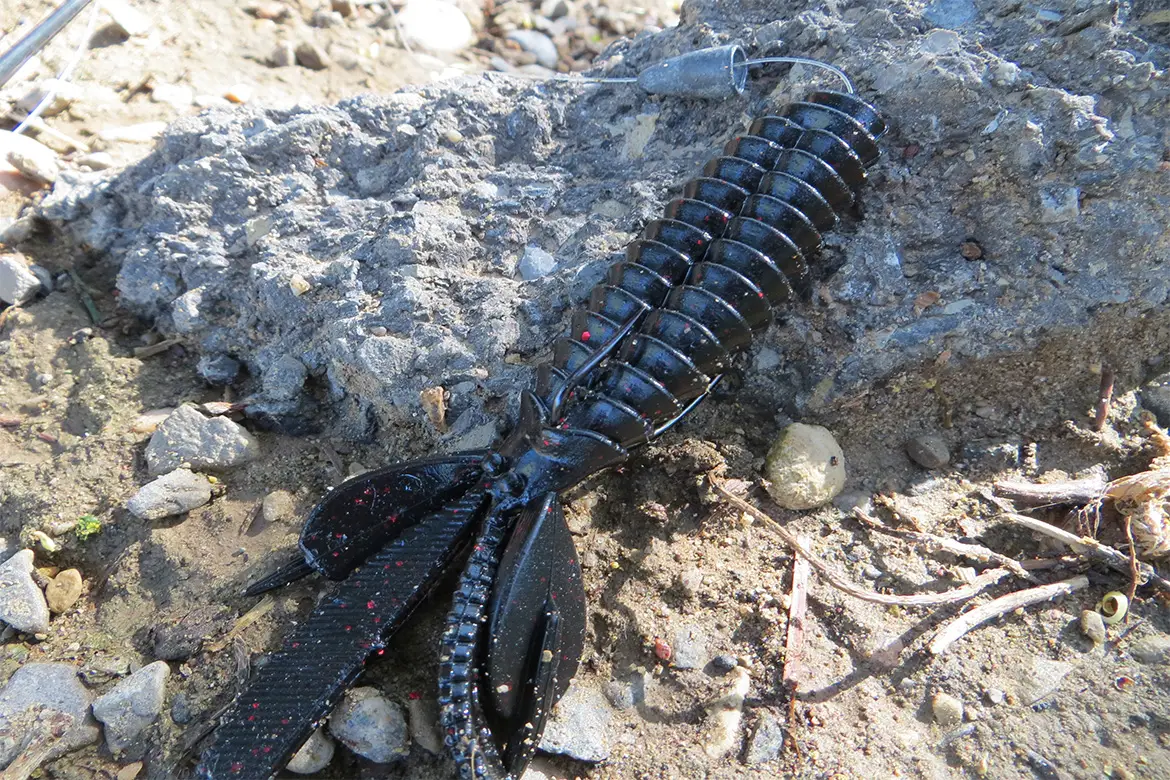The Texas rig is by far one of the most common and effective ways to fish soft plastic styled baits. You can throw a Texas rig pretty much at any time, any place and in any situation. This widely used technique is a simple and effective way to catch bass in cover and in open water throughout the year.
In this guide, we will cover the best rigging options, weights, hooks, baits, rod & reel setups and some tips and tricks that will help you catch more bass on a Texas rig.
What is a Texas rig?
A Texas rig is a popular bass fishing technique that is used for fishing soft plastic baits. It typically includes a bullet shaped weight that is made from tungsten or lead and some type of worm hook. The Texas Rig is considered a weedless rig which allows anglers to fish soft plastic baits into hard-to-fish cover like grass, trees, bushes, and other types of structure. Over the year’s anglers have made some small adjustments to this rig adding some slight variations which we will discuss later in this post.
How do you rig a Texas Rig?
Over time a few different variations of the Texas rig have been developed to adapt to the different fishing conditions anglers often find themselves in. There are three main ways anglers rig a Texas rig: a traditional Texas rig, a pegged Texas rig and a weightless Texas rig. Let’s go over the different types and when to use each one.
Basic Texas Rig
The standard Texas rig is made up of three components: a bullet weight, hook, and a soft plastic worm or bait. On a traditional Texas rig the weight isn’t “pegged” meaning the weight can freely slide up and down the line.
Having the weight independent of the line slows the fall rate of the bait and presents a more natural look to the fish. Since most bites on a Texas rig come on the fall this is a great way to present your bait and will help you catch more fish.

The basic Texas rig is ideal in open water situations and allows for a better hook up ratio. However, if you plan on fishing in heavy cover “pegging” your Texas rig is the way to go.
Pegged Texas Rig
When fishing in heavy cover it’s a good idea to “peg the hook”. Pegging the hook is a term used by anglers when they add a rubber bobber stopper or something similar that pins the weight to the top of the hook. This makes the rig more compact and prevents the bullet weight from sliding up the line.
Pegging the weight allows your bait to go through hard-to-fish cover without getting hung up. This is a great option when fishing in brush, over hanging trees, lily pads, grass and other types of heavy structure.
Adding a Bead

A great way to entice some more bites on a Texas rig is by adding some sound. This is especially effective when you’re fishing in muddy or stained water. This is accomplished by adding a plastic or glass bead in between the hook and the bullet weight. The weight will collide with the bead and create “clacking” sound that bass often mistake for
a crawfish. There are a few different color options available, but the color doesn’t make a big difference (in my opinion). It’s the added sound that you are after. This is a very simple addition but can be extremely effective, especially in muddy water conditions.
Weightless Texas rig
Fishing a weightless Texas rig is also a super effective way to catch bass. A weightless Texas rig is pretty self-explanatory. It’s a Texas rigged bait without the bullet weight. This rig is ideal in shallow water and thick cover or when the bass are a bit more finicky. This style is typically used while fishing a Drop shot, Carolina rig or some type of stick bait. One of my favorite ways to use this rig is fishing a weightless Senko in shallow cover. Bass simply can’t resist the slow action of a falling stick bait.
Advantages of a Weightless Texas Rig
- Better hookup ratio
- Easier to skip
- More of a natural presentation
- Longer fall rate
- Quite entry
Best Weightless Setup
- Worm- (5”-7”) Senko
- (Green Pumpkin/Blk Flake, Watermelon/Red)
- Hook- 4/0 Gamakatsu EWG
Texas Rig Weights: What weight should a Texas Rig Be?

There are a few things to consider when selecting the right bullet weight for your Texas rig setup. The type of structure that you plan to fish and the thickness of it should indicate the size of weight to use. In most cases, it’s best to use the lightest weight possible that you can get away with.
For thicker cover, you will want to use a heavier weight that allows your bait to cut through that thicker stuff. But there is a balance here. You also don’t want the bait to come crashing down spooking the fish. You will want a weight that is just heavy enough to get through the cover. In open water situations go with the lightest weight possible with still being able to feel what the bait/rig is doing at the bottom.
An overall great Texas rig sized weight is a ¼ ounce and is probably the one I use the most. However, I will go with a heavier or lighter weight depending on the area and structure that I am fishing or the fall rate that I am going for.
Colored Bullet Weights
There are a few different bullet weight color options to choose from. The main ones are silver, black and green. In my opinion, the color of the weight isn’t really a factor and is more of a personal preference. Any color of bullet weight will work just fine. The most important thing is to ensure you are fishing with the right size of weight in the right situations.
Tungsten vs. Lead Weights
The biggest advantage of using a tungsten weight compared to a lead weight is that it gives you increased sensitivity. Tungsten weights are denser than lead weights meaning it’s harder than lead. The harder material gives you a better feel for what your bait is doing at the bottom. The downside to tungsten is the price point. Lead weights are often a lot cheaper than tungsten. For tournament fishing I would definitely go with tungsten for the added sensitivity, but if you are just fishing for fun or with kids a lead weight isn’t a bad option either.
Texas Rig Hooks: What hooks should I use for a Texas rig?
The selection of your hook size should be determined by the size of worm or bait that you are using. The bigger the bait, the bigger your hooks should be. To determine the size of hook, place your bait flat along the shank of the hook and see how much space there is between the back of the bait and the point of the hook. If it doesn’t look like there is enough space, try a bigger hook or go with an extra wide gap style hook. If the hook seems to overpower the bait you many need to downsize.
Another thing to consider when selecting a hook for the Texas rig is how thick the bait you are going to be using will be. The thicker the bait, the stouter of hook you will need. This will help your hook penetrate through the bait and into the fish’s mouth when you go to set the hook. You should also think about the size of line that you will be fishing with. In general, heavier line will require a heavier hook. Light wire hooks straighten out before the line snaps, which takes away the advantage of using heavier line.
Choosing the right Type of Hook
Every anglers seems to have their own preference of hooks; offset shank, straight shank, round bend, extra wide gap as well as others. Whichever hook you prefer, the chosen hook should offer the point of the hook stuck back into the body of the worm or bait and the worm/bait itself having a straight profile when laid on a flat surface or suspended in the water.
What you want to avoid is a big bulge where the bait bunches up on the front of the hook. This won’t look as natural to the fish and will dramatically decrease your chances of having success.
We won’t go cover every hook out there in this article. Just know that every angler has a preference of style and brand of hook that they like to use. Instead we will cover the three most commonly used hooks (straight shank, offset round bend and extra wide gap) and discuss the advantages and applications of each style.
Before we dive in. A solid rule of thumb to go by is: Use the most compact gapped hook you can get away with, there will be less room for failure this way.
Straight Shank Hook

Most anglers that are pitching and flipping a Texas rig are going to be using a straight shank style hook. The main advantage of a straight shank hook on a Texas rig is that the hook angle points up. When you hook the straight shank hook back into the bait the point of the hook points up at roughly a 30-degree angle.
This angle gives you a better chance at hooking a bass at the top of the mouth and will increase your hook up ratio. The downside of this style is you will end up going through more baits and it tends to be not be as weedless.
- Advantages: Better hook up ratio
- Disadvantages: Harder on baits, not as weed-less
Offset Round Bend

The offset round bend it probably the most popular hooks when it comes to worm hooks and is probably most anglers preferred choice for traditional Texas rigging. These hooks are commonly used for large worms and creature style baits.
An offset shank is designed to allow anglers to more effectively rig large and bulkier soft plastics on the hook. The gap of the hook also provides space for the plastic to rest below the hook eye, instead of on a traditional bait keeper. In addition, the hook barb is further down the bait which helps increase your hook up ratio.
The offset round bend hook is used in open-water Texas rigging situations, dragging a worm on the bottom as well as throwing it into light cover.
- Advantages: Easier to rig, can use bulkier baits
- Disadvantages: Requires a harder hook set
Offset wide gap or extra wide gap (EWG)

An offset wide gap or an extra wide gap style hook is probably what I use the most when I am fishing with a Texas rig. However, most anglers prefer either a straight shank hook or an offset round bend style. I tend to go with this style over the others for a few different reasons: baits last longer on these compared to other hooks, and I can get a consistent presentation. But probably the main reason is that I just have confidence in these hooks because they have always worked for me in the past.
This style of hook excels at fishing thicker soft plastic baits due to the larger gap. The bigger gap provides plenty of room for the soft plastic bait to get out of the way of a positive hookset.
The downside to the offset wide gap or extra wide gap is that the barb of the hook is directly in line with the eye of the hook. This increase your chances of losing a fish by not getting a proper hookset due to the angle.
But overall the ease of threading a bait in a perfect position and being able to fish big soft plastic baits in rough terrain is why I am a fan of this style of hook.
- Advantages: More weedless, baits will last longer, more consistent presentation
- Disadvantages: Barb is directly in line with the eye of the hook, requires a bigger hook set
How to fish a Texas Rig

Now that we have a solid understanding of the different components and rigging options, let’s take a look at some of best ways you can fish a Texas rig.
Over time and especially in recent years the term “Texas Rig” has come to mean the weedless method of putting the bait on the hook with or without a weight. Nowadays there are so many variations of the Texas rig that it can become confusing when you are just starting out.
But put simply, when anglers talk about Texas Rigging they are referring to rigging their bait weedless and it could mean they are Texas rigging on a drop shot, Carolina rig, swim-bait or with any other technique. Below we have included some of the most common techniques anglers use to rig and fish a Texas rig.
Keep in mind this is only a good starting point, and I would encourage you to try these techniques and methods as well as experiment and find out for yourself what works best.
Pitching and Flipping
Pitching and Flipping a Texas rigged bait is one of my favorite ways to catch bass. There is just something about making a pitch or a flipping into some type of structure and seeing your line swim away. Pitching and flipping plastic creature baits is an effective way to catch fish. Go check out this article: Everything You Need To Know About Flipping and Pitching for more details about this technique.
Lift and Drop
This style of fishing works well on points, flats, ledges and other open water situations. Simply make a cast to your target and slowly hop your bait by lifting and dropping your rod. This method is great at mimicking a crawdad hopping around or a small bait fish feeding on the bottom.
Swimming
Another common way anglers will fish a Texas rigged style bait is by swimming it. Swimming a creature or baitfish styled bait can be a great way to give the fish a new look. Texas rigging a swimbait can be an awesome way to catch fish in cover. Check out this video on how to Texas rig a swimbait for additional information.
Drop Shot
A drop shot is an all time great way to catch bass and is one of my favorites. However, its not ideal for fishing in heavy cover. That’s where Texas rigging comes into play. By Texas rigging your drop shot baits you get the advantage of a drop shot as well as the weedless capabilities of a Texas rig.
Carolina Rig
The Carolina rig is another great example on how effective rigging your bait Texas rigged style can be. The Carolina rig is similar to the traditional Texas rig but instead of having the weight snug up against the bait, the weight is tied to a leader which is then followed by the bait. For more Carolina rig information go check out this article: Carolina Rig: Everything You Need to Know
Where can you fish a Texas Rig?
One of the things that makes the Texas rig such a great bass fishing rig is its versatility. The Texas rig can be thrown at any time, any place and in pretty much any condition. Because it is so versatile there really isn’t a wrong place to fish it. However, there are some areas and terrains where this rig really shines. Here is a quick list of some productive areas you should look to target with a Texas rig:
- Laydowns
- Bushes
- Boat docks
- Tullie’s
- Lily pads
- Grass
- Trees
- Wood
- Main lake points
Best Texas Rig Baits
A Texas rig is versatile rig that you can pair pretty much any soft plastic bait with. Worms, tubes, creature baits all work really with this rig. Here is a list of some of the best Texas rig worms and creature baits:
Top Texas Rig Baits
- Yamamoto Senko (Also works great weightless)
- Sweet Beaver
- Brush Hog
- Baby Brush Hog
- Man Bear Pig
- Yamamoto Hula Grub
- Berkley Powerbait 7″ Power Worms
- Berkly Havoc Smash Tube
How to choose the right soft plastic color
Many anglers often ask, “what is the best soft plastic color, and how do I choose the right one?” If you walk into any tackle shop you will notice the thousands of different options out there. I like to keep it simple.
In muddy waters I like to fish with dark and bright colors. My favorite colors for this situation are a black and blue or a black and purple. In contrast, in clear water situations, I will stick to more natural colors such as browns, green pumpkins.
Muddy water = Dark or bright colors
Clear water = Green pumpkins, whites and browns
Common Texas Rig Fishing Mistakes
Although it’s hard to find a wrong way and place to fish a Texas rig, there are some common mistakes anglers often make with this technique. Here some frequent mistakes every anglers should avoid:
- Fishing to fast
- Waiting too long to set the hook
- Having the rod too low
- Not having the bait rigged straight on the hook
- Not selecting the right weigh and hook combination
What Rod and Reel to use for Texas Rigs
An overall great rod and reel setup for a Texas rig is a medium-heavy or heavy action rod with a high great ratio reel (7.1:1 to 8.1:1). But before selecting this setup you should also consider the following: type of structure and the areas you plan on fishing, bait and line size as well as how big are the fish you are targeting. Here is a simple guide to help you get you started:

Heavy Cover – Fishing in heavy cover? You are going to need some heavy tackle to get the job done. If I am pitching and flipping into some thick stuff, I like to use a heavy action rod with heavy braided line paired with a reel that has a high great ratio, so that I can quickly get the fish out of the cover when I hook up.
Open Water or Sparse Cover – In open water situations or in areas with sparse cover I’ll go with a medium action rod. In this situation, I will typically be fishing on some type of point or flat so the extra bend in the rod makes it easier to cast.
Light Bait and Cover – If I am throwing a light weight bait and there isn’t much cover around, I’ll power down and go with a medium-light action rod. Lighter weights and baits call for a lighter setup. This type of rod makes it easier to cast smaller baits.
Final Thoughts
The Texas rig is an absolute beast of a rig and one that every angler should learn and have tied on. You can through this rig in so many different ways and can fish it pretty much any time, and anywhere. I hope you have found this information to be insightful and that you use it to get out there and catch some more bass on a Texas rig. Be sure to check out our other articles here on Tilt Fishing. We appreciate you stopping by.
Tight Lines!

